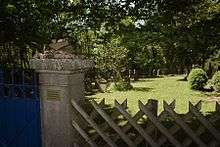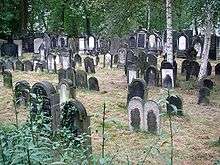Jewish cemetery


A Jewish cemetery (Hebrew: בית עלמין beit almin or בית קברות beit kvarot) is a cemetery where members of the Jewish faith are buried in keeping with Jewish tradition. Cemeteries are referred to in several different ways in Hebrew, including bet kevarot (house of tombs), beit almin or bet olam (house of eternity), the bet chayyim (house of the [eternal] life) and bet shalom (house of peace).
The land of the cemetery is considered holy and a special consecration ceremony takes place upon its inauguration. According to Jewish tradition, Jewish burial grounds are sacred sites and must remain undisturbed in perpetuity. Establishing a cemetery is one of the first priorities for a new Jewish community. A Jewish cemetery is generally purchased and supported with communal funds.[1]
Showing proper respect for the dead (kevod ha-met) is intrinsic to Jewish law. The connection between the soul and the human body after death is an essential aspect of Jewish belief in the eternity of the soul. Thus, disinterring the dead, deriving benefit from a corpse or grave, or acting in any way that may be perceived as "ridiculing the helpless" (l’oeg l’rash), such as making derogatory remarks or joking, but also partaking in the pleasures or needs of the living, such as eating, drinking or smoking, are forbidden in the presence of the dead.[2]
Showing proper respect for the dead also requires a prompt burial, the waiver of certain rabbinic restrictions on Shabbat and religious holidays to insure proper care of the dead, the ritual cleaning (tahara) and dressing of the body in shrouds (tachrichim) before burial, and laws concerning proper conduct in a cemetery.
To ensure that the requirements for Jewish burial are met and that each member of the community is afforded a proper burial, Jewish communities establish burial societies known as the Chevra Kadisha (The Holy Society) to provide these services free of charge. In larger Jewish communities, cemeteries are sometimes subdivided into sections according to the chevra kadisha that uses and is responsible for that section of the cemetery's care and upkeep.
History
Early Jewish cemeteries were located outside of the city. In the Diaspora, it is traditional to bury the dead with the feet in the direction of Jerusalem. The tombstones usually have inscriptions in Hebrew and the regional language. During the Nazi Germany regime, Jewish cemeteries all over Europe were destroyed and desecrated.
The largest Jewish cemeteries of Europe can be found in Budapest, Łódź, Prague, Warsaw, Vienna and Berlin. Other Jewish cemeteries in Europe include the Jewish Cemetery in Khotyn and the Chatam Sofer Memorial (part of the Old Jewish Cemetery in Bratislava).
International Jewish Cemetery Project
The mission of the International Jewish Cemetery Project is to document every Jewish burial site in the world.[3]
See also
References
- ↑ "IAJGS cemetery site". Iajgs.org. Retrieved 2012-12-25.
- ↑ Lamm, M (2000). The Jewish Way in Death and Mourning. New York: Jonathan David Company Inc.
- ↑ "International Jewish Cemetery Project". Iajgs.org. 2010-08-23. Retrieved 2012-12-25.
| Wikimedia Commons has media related to Jewish cemeteries. |
External links
- IAJGS International Jewish Cemetery Project
- JewishGen Online Worldwide Burial Registry
- Database of European Jewish Burial Grounds


